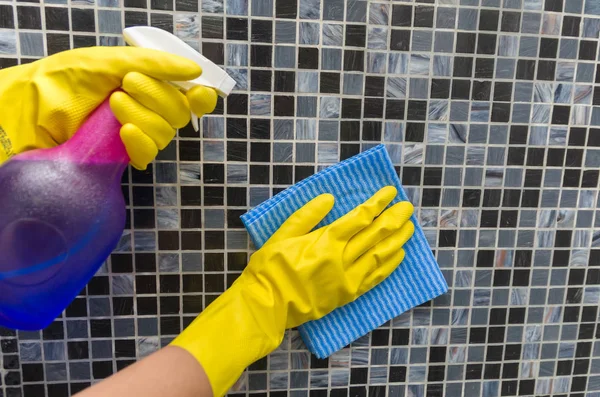Cleaning bathroom tiles not only keeps them looking fresh and clean but also prevents the build-up of grime and soap scum. Regular cleaning helps maintain hygiene and prevents the growth of mold and mildew, ensuring a healthy bathroom environment.
Why is it Important to Clean Bathroom Tiles Regularly?
Regularly cleaning bathroom tiles is essential to maintain a hygienic and mold-free environment. Let’s explore the significance of regularly cleaning bathroom tiles and how it contributes to a clean and healthy bathing space.
Prevents Build-up of Grime and Soap Scum
- Regular cleaning removes dirt and residues that can accumulate on the tiles over time.
- Clean tiles provide a clean and hygienic surface, reducing the risk of bacteria and germs.
- Cleaning also helps to preserve the longevity of the tiles, preventing them from becoming dull or damaged.
Maintains Hygiene and Prevents the Growth of Mold and Mildew
- When cleaning bathroom tiles, make sure to scrub them thoroughly to remove stubborn stains or any signs of mold growth. Use a brush or sponge to reach into grout lines and crevices where mold and mildew can hide.
- Adequate air circulation plays a vital role in keeping bathroom tiles dry and reducing the moisture level in the room. You can achieve this by opening windows or using exhaust fans to remove excess humidity.
How to Clean Bathroom Tiles
Say goodbye to surface dirt and grime as we reveal the secrets to achieving a pristine tile surface. Dive into the nitty-gritty of cleaning grout lines and discover the best techniques for a thorough rinse and dry.

Prepare the Tiles
- Use a broom or vacuum cleaner to effectively eliminate loose dirt and debris from the tiles. This precaution helps prevent any potential scratching of the surface during the cleaning process.
- Dampen a clean cloth or sponge with warm water and gently wipe down the tiles. This action assists in softening any grime or stains, thus preparing the surface for a more thorough cleaning.
- Mix a small amount of mild detergent or a specific tile cleaner with warm water as instructed by the manufacturer. Apply the solution to the tiles and gently scrub with a soft brush or sponge.
- Utilize a grout brush or an old toothbrush to effectively clean the grout lines between the tiles. Scrub in a circular motion to successfully remove any dirt or discoloration.
Remove Surface Dirt and Grime
- Apply the cleaning solution onto the tile surface using a sponge or cloth.
- Gently scrub the tiles in circular motions to loosen and lift the embedded dirt and grime.
- For more stubborn stains, create a paste by mixing baking soda with a small amount of water.
- Apply the baking soda paste onto the areas affected by stains and allow it to sit for several minutes.
- To target the stained areas, use a soft brush or toothbrush to scrub and further remove dirt and grime.
- Rinse the tiles thoroughly with clean water to eliminate any residue left by the cleaning solution and baking soda paste.
Tackle Tough Stains
- Determine the type of stain you are dealing with, whether it’s from hard water, soap scum, mold, or mildew.
- Spray or apply the cleaning solution directly onto the stained area.
- Allow the solution to sit on the stain for about 10 minutes to loosen the grime.
- Use a scrub brush or sponge to gently scrub the stained area, applying some pressure if necessary.
- Thoroughly rinse the tiles with clean water to remove the cleaning solution and any remaining residue.
Clean Grout Lines
- Create a cleaning solution by combining equal parts water and vinegar, and then apply it directly to the grout lines.
- Vigorously scrub the grout lines using either a grout brush or an old toothbrush, focusing on one small section at a time.
- Rinse the grout lines thoroughly with clean water. Use a damp cloth or sponge to remove any leftover residue.
- For stubborn stains or the presence of mold/mildew, a hydrogen peroxide solution can be applied to the grout lines. Let it sit for a few minutes before scrubbing and rinsing.
- Regular maintenance is crucial for keeping grout lines clean. After each use of the bathroom, wipe down the grout lines with a damp cloth or sponge to prevent build-up.
Rinse and Dry
- Thoroughly rinse the tiles with water using either a clean bucket or a handheld showerhead.
- Pay special attention to the grout lines and use a clean sponge or cloth to wipe away any remaining dirt or soap residue.
- After rinsing, dry the tiles using a clean microfiber cloth or a squeegee. Start from the top and work your way down to avoid water spots or streaks.

Tips for Maintaining Clean Bathroom Tiles
- It is important to clean bathroom tiles regularly to prevent the buildup of dirt and grime. Use a mild cleaning solution and a soft sponge or cloth to wipe down the tiles. Avoid using abrasive cleaners that can damage the tiles.
- The grout between the tiles can easily accumulate dirt and stains. Scrub the grout lines with a grout brush and a mixture of baking soda and water. Rinse thoroughly to remove any residue.
- Harsh chemicals can damage the tiles and grout. Stick to natural cleaning solutions or mild detergents to clean bathroom tiles.
- To prevent soap scum and water stains, wipe down the tiles after every use. Use a squeegee or a dry cloth to remove excess water.
- Applying a grout sealer once a year can help protect the grout from stains and make it easier to clean.
If you are in Minneapolis, Minnesota or from a nearby area looking for a cleaning solution, just reach out to us and let Ivy Cleans handle your cleaning needs.
